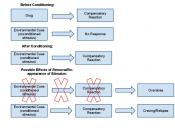Though classical conditioning and operant conditioning are both techniques involving learning and the acquisition of behaviors, they have contrasting--but sometimes complementary-- ways of training. However, with pioneers in each conditioning practice believing in the general principle, "Psychology should be based on experimental investigation of behaviors," the two fields often intersect.
Classical conditioning was brought to the forefront of psychology via Ivan Pavlov's experiments with dogs. His theory suggested that an organism could learn to associate one stimulus it expected and responded to automatically with a stimulus that held no prior importance to the organism. In his experiments, Pavlov would have the original stimulus, or the unconditioned stimulus (UCS), follow the non-important stimulus, or neutral stimulus (NS), when presented to the dogs. He would then observe the innate reaction to the UCS, or the unconditioned response (UCR), to the original UCS. Eventually, through repetition of the pairing (association) of the NS and the UCS, the dogs would begin to demonstrate the same innate behavior to the NS alone.
This was a major breakthrough: the NS was no longer neutral; it became a conditioned stimulus (CS), and the once-unconditional response now became a conditioned response (CR).
Through further experimentation with this base knowledge, Pavlov identified five major conditioning processes: acquisition, extinction, spontaneous recovery, generalization and discrimination. Acquisition defined the initial stage of the conditioning process when the association of the NS with the UCS took place. The organism acquires an expectation that the NS comes to signal a UCS, and consequently responding accordingly. When a CS is no longer followed by the UCS, extinction occurs and the CS will eventually cease to elicit a CR. In simpler terms, the number of responses decreases, or becomes extinct. An extinguished CS can, however, make a random appearance after a 'rest period' between...



Very Good and funny TOO!!!
Great Read!
0 out of 0 people found this comment useful.